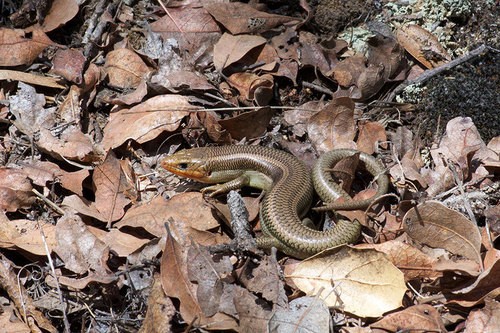Plestiodon skiltonianus skiltonianus
A species of Skinks Scientific name : Plestiodon skiltonianus skiltonianus Genus : Skinks
Plestiodon skiltonianus skiltonianus, A species of Skinks
Scientific name: Plestiodon skiltonianus skiltonianus
Genus: Skinks
Content
Description General Info
 Photo By sullivanribbit , used under CC-BY-NC-4.0 /Cropped and compressed from original
Photo By sullivanribbit , used under CC-BY-NC-4.0 /Cropped and compressed from original Description
Plestiodon skiltonianus skiltonianus is a fascinating reptile with intricate survival strategies. Known for its autotomy, the ability to self-amputate its tail to escape predators, it has proven its adaptability in the wild. Residing in varied habitats from coastal dunes to high mountains, it demonstrates a wide ecological range. Its omnivorous diet includes spiders, insects, snails, and vegetation, offering an exploration into intricate feeding mechanisms.
General Info
Lifespan
10-15 years
Diet
Plestiodon skiltonianus skiltonianus predominantly feeds on small invertebrates, particularly insects. Its diet includes a large spectrum of beetles, spiders, and crickets, but it shows a particular fondness for moth larvae and ants.
Appearance
Plestiodon skiltonianus skiltonianus is a medium-sized lizard with smooth and glossy scales. It has a long, stout body, a tapered tail, and broad head. Its primary color is dark blue to black, often spotted with light-colored flecks. Males have orange vents and throats, especially during the breeding season. Juvenile plestiodon skiltonianus skiltonianuss are more vibrant, with blue tails and bodies that are heavily spotted with pale spots.
Behavior
Plestiodon skiltonianus skiltonianus is a diurnal and predominantly terrestrial species exhibiting cryptic behavior. Notably solitary, they are skilled burrowers, opting for self-dug burrows or employing existing ones. Agile climbers, they also seek refuge in crevices and under barks. Foraging on foot, plestiodon skiltonianus skiltonianus displays omnivorous behavior, feeding on both invertebrates and plant matter. Their conspicuous blue tails act as distraction for predators, ensuring survival.